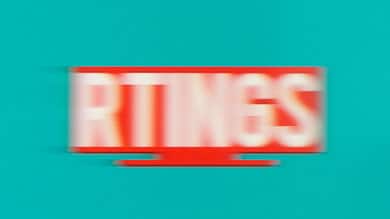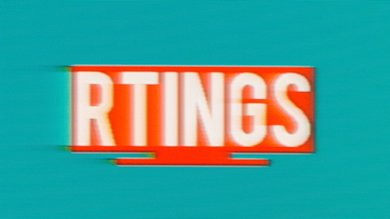
A camera on a rail, being used as a pursuit camera, is used to track on-screen motion while taking a photo. This allows accurate motion blur comparisons, similar to moving human eyes tracking on-screen motion.
Pursuit camera photos are also on this site:
Photos: LCD Motion Artifacts 101
Photos: LCD Overdrive Artifacts
Photos: 60Hz vs 120Hz vs LightBoost
Here are some excellent photos of of motion blur taken by the RTings. The RTings logo is moving at 960 pixels/second, while a camera takes a photo of the logo during a 1/30sec exposure:

Sony W800B, interpolation disabled

Sony W800B, interpolation disabled

Sony W800B in Motionflow Impulse Mode
It is easy to see the LCD GtG pixel transition slowness showing up in the images. The pixel transition effects (GtG) is seen as the ghosting effects occuring at the left edge behind the motion blurring. This GtG artifact is occuring independently of the persistence-based motion blurring. GtG artifacts is not the same as persistence-based motion blurring. It is already quite obvious, that the persistence-based motion blur out-dominates GtG-based artifacts, at least during the 960 pixels/second motionspeed (representative of fast motion, like sports and videogames) on this display.
Stationary cameras do not accurately capture display motion blur during eye-tracking situations. Thus, pursuit camera tracking of on-screen motion is a vastly far more accurate approximation of eye-tracking of on-screen motion. It makes possible a greater degree of objective comparative display motion blur analysis than stationary camera photography of displays.
RTings’ test method, based on the Blur Busters setup, is quite simple. Rather than a UFO (which Blur Busters uses on www.testufo.com), they use an RTings logo graphic scrolling left-to-right at 960 pixels/second (moderately fast motion). The motion itself creates motion blur, which is thus accurately captured by pursuit camera (camera-tracking as an approximate equivalence of eye-tracking). Scientific papers (example: “MPRT pursuit camera” on Google Scholar) have long used the pursuit camera technique scientific measurement of motion blur. However, pursuit cameras were not cheap enough for websites/bloggers to use until a simple invention permitted easy verification of tracking accuracy via a temporal test pattern.
Additional Photo Examples
A photograph is worth a thousand words, and far more relevant to readers/users than an “1080 lines of motion resolution” FPD test. These are completely intuitive and self-explanatory photographs of very common LED HDTV motion artifacts, found on three different models of LED-backlit LCD HDTVs:
Severe Ghosting
Severe ghosting — This GtG artifacts often looks like this when you have little or no overdrive, and/or when the LCD panel is very cold (cold VA LCDs create much longer ghost trails than when warmed up; the common advice to warm up your display before testing applies to LCDs too). Also, low-quality backlight strobing is occuring with this one, creating severe multi-image effects. (Toshiba L1400U, default)
Inverse Ghosting
Bright ghosting — This GtG artifact is called a corona, or inverse ghosting. The ghosting is brighter than the original pixels. This is caused by agressive overdrive (response time acceleration) overshooting its final pixel color value. (Samsung H7150, MCFI=ON)
Inconsistent ghosting
Inconsistent ghosting — Look at the corners of the logo. This GtG artifact is caused by inconsistent GtG response speeds. Some pixels are slower than others. The pixels at the upper-left corner and upper-right corner of RTings are transitioning slower, because the pixels have been staying red longer than the pixels in the middle of the logo, where there a lot of white pixels. (Samsung H6350, MCFI=ON)
Conclusion
It is clear that the pursuit camera technique is a wonderful comparative tool that needs to be introduced to more display websites, display magazines, and display blogs. While not everyone cares about motion blur, there are parts of the audience that cares very much, including the Blur Busters audience, as well as plasma motion resolution lovers, and people who miss CRT motion clarity. In the past, pursuit camera setups were extremely complicated, super expensive ($ in 4 and 5 figures), and very hard to do. However, the simple Blur Busters pursuit camera technique is very easy and inexpensive thanks to the cost-cutting technique (off-the-shelf camera slider rail + favourite off-the-shelf camera or SLR + my temporal test pattern for tracking accuracy verification) that manage to achieve lab-quality tracking accuracy without the cost.
Related Reading
- Google Scholar “MPRT pursuit camera”
— pursuit cameras precent for scientific display motion measurement - RTings Motion Blur TV Photography
— photography of motion blur; and scroll down to see credit for my invention - Blur Busters announcement of RTings using my invention
— a few weeks ago - BlurBusters.com: Instructions on Temporal Test Pattern
— scroll several pages down to see how the temporal test pattern is used as tracking accuracy verification - TestUFO.com: Temporal Test Pattern Example #1 – Ghosting
— look at the black strips with the temporal test pattern, looks accurate only during correct tracking. This is the tracking-accuracy-verification temporal test pattern that I gave RTings permission to use. - TestUFO.com: Temporal Test Pattern Example #2 – Moving Photo
— look at the temporal grid overlay that only looks accurate during correct tracking








